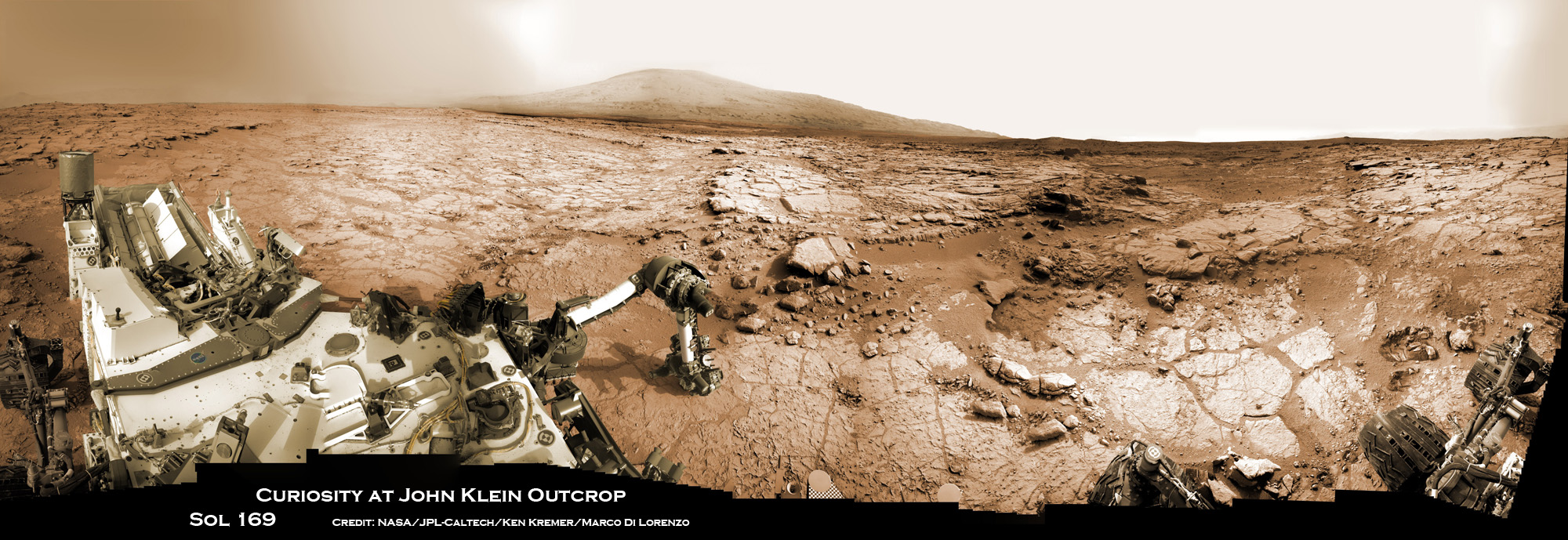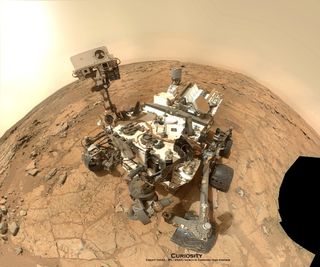
Three spectacular new panoramas give an eye-popping look at NASA's Mars rover Curiosity hard at work on the Red Planet.
Each photo is a mosaic stitched together using more than 20 raw images taken by the Curiosity rover itself, said New Jersey-based scientist and journalist Ken Kremer, who created the panoramas along with his imaging partner Marco Di Lorenzo.
The mosaics "show the context for each spot where the rover is toiling away — compared to individual frames that just give a rather narrow view and incomplete experience," Kremer told SPACE.com in an email. "The wide view lets you experience Mars as if you were standing on the Red Planet's surface — and from the human perspective." [Mars Rover Curiosity's Latest Photos]

One of the mosaics shows Curiosity with its huge robotic arm deployed, studying a rocky outcrop called "John Klein" on Jan. 25-26, 2013. About two weeks later, the rover drilled 2.5 inches (6.4 centimeters) into a section of John Klein, collecting the first-ever samples from the interior of a Martian rock.
Another mosaic is a self-portrait Curiosity took at John Klein on Feb. 3. The third shows Curiosity on March 23, still at the drill site, with its arm elevated and its drill pointed at the viewer — seemingly flexing its muscles after recovering from a computer glitch that knocked out its main computer system in late February.
The mosaics help paint a picture of Curiosity and its mission, which aims to assess Mars' potential to host past or present microbial life, Kremer said.
"I chose these scenes because they vividly tell the story of what NASA seeks to accomplish with Curiosity in the search for signs of life on Mars as well as tell the science story of the entire mission at a glance — one panorama is worth a thousand words, so to speak," he said.
Get the Space.com Newsletter
Breaking space news, the latest updates on rocket launches, skywatching events and more!

Curiosity has already accomplished its main mission goal. The rover's analysis of the John Klein drill samples enabled mission scientists to determine that the Red Planet was indeed habitable billions of years ago.
The rover team made this announcement in March, just seven months after Curiosity touched down inside Mars' huge Gale Crater.
Two of the three new photo mosaics prominently feature Mount Sharp, the mysterious 3.4-mile-high (5.5 km kilometers) mountain that rises from Gale's center. That's no accident, Kremer said.
"Whenever possible with horizon scenery we include Mount Sharp — it's a dramatic backdrop as well as being the rover's ultimate destination," he said.
For more information about Ken Kremer and his photo mosaics, visit http://www.kenkremer.com/
Follow Mike Wall on Twitter @michaeldwall and Google+. Follow us @Spacedotcom, Facebook or Google+. Originally published on SPACE.com.
Join our Space Forums to keep talking space on the latest missions, night sky and more! And if you have a news tip, correction or comment, let us know at: community@space.com.

Michael Wall is a Senior Space Writer with Space.com and joined the team in 2010. He primarily covers exoplanets, spaceflight and military space, but has been known to dabble in the space art beat. His book about the search for alien life, "Out There," was published on Nov. 13, 2018. Before becoming a science writer, Michael worked as a herpetologist and wildlife biologist. He has a Ph.D. in evolutionary biology from the University of Sydney, Australia, a bachelor's degree from the University of Arizona, and a graduate certificate in science writing from the University of California, Santa Cruz. To find out what his latest project is, you can follow Michael on Twitter.